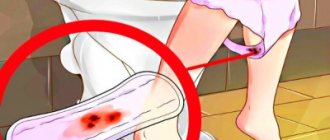The appearance of white plaque on the walls of the vagina is a clear sign of a violation of the natural balance of the vaginal microflora. There are various reasons for the appearance of plaque and whitish discharge, the main ones being:
- Vaginal candidiasis;
- Bacterial vaginosis;
- Venereal infectious processes, such as gonococcal infection, ureaplasmosis, trichomonas infection;
- Vulvovaginitis;
- Dysbacteriosis;
- Avitaminosis;
- Allergic reaction to intimate hygiene products;
- Inflammatory processes in the uterine appendages (adnexitis);
- Inflammation of the cervix (cervicitis);
- Inflammatory processes in the endometrium of the uterus (endometritis);
- Changes in climatic conditions.
Etiology
The most common cause of white plaque in the vagina is vaginal candidiasis (thrush). This disease is caused by the activation of opportunistic flora in the form of the yeast-like fungus Candida albicans. This bacterium is a component of the normal vaginal microflora in a woman, however, when unfavorable conditions are created, it is activated, active growth and reproduction of the fungus occurs, resulting in an odorless white coating in the vagina or milky-white thick discharge.
Factors that activate the reproduction of Candida albicans include the following:
- Long-term use of antibiotic drugs, oral contraceptives, drugs for hormonal therapy;
- Decreased natural immunity;
- Venereal pathologies;
- Changes in hormonal levels associated with the onset of menopause;
- Pregnancy;
- The presence of systemic and endocrine pathologies (diabetes mellitus, atopic dermatitis);
- Intestinal dysbacteriosis and helminthic infestations;
- Poor nutrition;
- Frequent change of sexual partners;
- Chronic diseases in the acute stage;
- Wearing tight underwear made of synthetic fabrics;
- Anal sex;
- Failure to comply with personal hygiene rules.
Thrush and vaginal rashes
Candidal vaginitis can cause rashes.
At the same time, white discharge appears.
There is an unpleasant sour smell.
Upon examination, white deposits are found on the reddened vaginal mucosa.
The most common complaint among women is painful itching.
When urinating, the vulva may burn.
Sexual intercourse is painful.
The vaginal mucosa is swollen.
Sometimes papules, erosions, and cracks form.
A pustular rash is also possible.
In this case, after the elements resolve, sores may appear.
The disease is of fungal origin.
It is transmitted sexually.
Although it more often develops as an endogenous infection.
Many women are carriers of candida fungus.
It usually does not cause any symptoms.
But in some situations, the number of fungi increases significantly, which results in an inflammatory process.
This occurs as a result of decreased immunity, hypothermia, and taking antibiotics.
At risk are patients with diabetes mellitus and HIV infection.
Their candidiasis is severe, spreads to other organs, and constantly recurs.
Symptoms
The development of vaginal candidiasis can be suspected in the presence of one or more of the listed factors, as well as in certain clinical symptoms characteristic of this pathological process:
- The presence of white plaque inside the vagina (on the mucous membranes of the walls);
- White coloring of the vaginal opening;
- The presence of thick white discharge in the form of cheesy masses;
- Pain and cutting during urination;
- Intense itching and burning in the area of the external genitalia (does not go away even after hygiene measures);
- Redness (hyperemia), swelling of the labia majora and minora.
Syphilis and vaginal rashes
Among STDs, vaginal rashes are often caused by Treponema pallidum.
This is the causative agent of syphilis.
The rash occurs in the primary and secondary periods.
In the primary, a painless erosion or ulcer appears.
It is red in color.
Located on a compacted base.
In the secondary period, elements of the rash appear not only in the vagina.
They can form on any part of the body.
Roseola and papules also appear in the vagina.
In the tertiary period, gummas or tubercles may form.
They heal with the formation of scars in the vagina.
Candidiasis during pregnancy
The appearance of white plaque in the vagina during pregnancy is a consequence of changes in hormonal balance , which has a certain effect on the vaginal microflora. In pregnant women, signs of vaginal candidiasis are usually more pronounced than in non-pregnant women. It is very important to start treatment on time, since untreated candidiasis in pregnant women has a negative impact on the health of the mother and newborn: premature rupture of amniotic fluid and complications during childbirth are possible; During the postpartum period, candidiasis may spread to the nipples, which entails a risk of infection of the newborn.
It should also be noted that young children are very susceptible to the effects of bacteria, so there is a high risk of candidiasis spreading in a child not only to the oral cavity, but also to the skin and mucous membranes of the eyes (development of conjunctivitis) and genitourinary organs.
Causes of rashes in women
Rash and single pimples on the female genital organs definitely cannot be considered a variant of the norm. Such symptoms should be a reason for an unscheduled visit to the gynecologist. Possible reasons for its appearance include:
- Natural factors, for example, incorrectly selected underwear or improper hygiene.
- Aggression of various parasites.
- Inflammatory processes in the hair follicles or glands.
- Viral diseases, such as herpes.
- Fungal infections.
- Benign neoplasms.
- Dangerous diseases, for example, syphilis, etc.
It is quite difficult to determine on your own what caused the alarming symptoms. To make a correct diagnosis, various laboratory tests are usually performed.
Why did white dots appear in the crotch?
White dots, similar to small pustules, often appear on the labia majora due to:
- Wearing uncomfortable underwear, particularly tight or too tight underwear.
- The occurrence of the greenhouse effect when using synthetic underwear.
- Insufficient hygiene.
- Individual reaction to hygiene products, for example, intimate hygiene gels, pads, etc.
- Shaving. In this case, pimples may appear on the skin in places where hairs grew due to infection entering the tiny wounds.
White pimples on the labia can cause severe discomfort: they ache and itch. If the cause of their appearance is not corrected, they can lead to a widespread inflammatory process.
Red spots or blisters on intimate organs
Red spots may well appear when pustules burst, arising against the background of the reasons we described just above. But sometimes the appearance of blisters in the perineum can be explained by other factors:
- Bites of skin parasites, which can be picked up during sexual intercourse or when visiting a swimming pool (sauna, etc.). It is very difficult to see them with the naked eye, but the bite sites are easily visible - they look like itchy red spots or blisters.
- Allergic reaction. Red spots or blisters that look like nettle stings are a common sign of allergies. In the area of intimate organs, in particular on the labia minora or majora, it can be caused by cosmetics, pads, latex, local contraceptives, etc. Manifestations of allergies usually itch noticeably and also lead to some swelling of the epidermis.
Red spots on the labia minora and majora may well appear due to various sexually transmitted diseases. In such a situation, they are constantly irritated by abnormal secretions. But with such diseases, other symptoms still come to the fore - the discharge itself, itching and burning, etc.
Single painful inflammation
If a single painful pimple appears on the labia, it may be a manifestation of a developing boil - an acute inflammatory process in the hair follicle, sebaceous gland, and surrounding connective tissue. This condition is most often caused by bacteria, and it can develop after injury (for example, received while shaving). You can suspect the development of a boil by:
- Severe painful sensations.
- The formation of a red and swollen area, similar to a large pimple.
- The appearance of a purulent head at the top of the pimple (after 2-3 days).
- Deterioration of general condition and increase in temperature (not always).
Typically, a boil on the labia opens on its own and then heals. But due to its special location, such a pimple can lead to the spread of infection, so it is better to treat it under the supervision of a doctor.
Inflammation of the Bartholin gland
A large internal pimple at the entrance to the vagina may be a manifestation of the inflammatory process in the Bartholin gland. This common disease is also known as bartholinitis. As you know, the Bartholin gland is a steam gland and is located at the very entrance to the vagina. Its inflammation can be provoked by injuries, surgical interventions in the area of the external genitalia, immune disorders, wearing tight underwear, etc. The causative agents of the disease can be a variety of pathogenic microorganisms. You can suspect the development of bartholinitis based on the following symptoms:
- Redness of the labia minora near the vagina.
- The formation of a small nodule (internal pimple), up to the size of a pea.
- Swelling of mucous membranes.
- The appearance of a slight burning sensation, which is subsequently supplemented by moderate pain. When suppuration occurs, the pain becomes especially pronounced.
- A slight increase in temperature - up to 37.5 ° C, with suppuration - higher.
- Discomfort when walking.
You can cope with non-purulent bartholinitis using conservative therapy - it is only important to consult a doctor in time. But if the disease is accompanied by suppuration, surgical intervention is performed.
Blisters on the genitals
If pimples on the labia look like blisters, their development is most likely due to the activity of the herpes virus. This disease is considered quite contagious; unpleasant symptoms can appear after sexual contact with a sick person or due to the banal transfer of the virus from the mucous membranes of the lips to the intimate organs (with insufficient hygiene). Genital herpes is accompanied by quite striking symptoms:
- Burning, itching and swelling in the intimate organs.
- The appearance of bubbles filled with liquid contents. They subsequently burst, dry out, form crusts, and eventually fall off.
- Enlarged lymph nodes, manifestations of intoxication.
The danger of herpes is that once infected, there is no way to completely eliminate the virus from the body. Subsequently, the disease can recur, and the risk of repeated manifestations can be reduced only through proper treatment and targeted strengthening of the immune system.
Causes of painless rashes
New growths may appear on the female labia that look like pimples, but do not cause any particular discomfort. Such elements may be:
- Manifestations of HPV - human papillomavirus. This disease is considered quite common; it can be contracted through direct contact, as well as through blood. The activity of the virus in the presence of predisposing factors (decreased immunity, microtrauma, etc.) leads to the appearance of condylomas on the genitals. Such neoplasms look like small flesh-colored growths of unequal size. Condylomas have a soft structure; as they grow, it is clear that they are located on a thin stalk. They can occur not only on the labia, but also in the vagina, as well as on the skin near the anus, etc. Such neoplasms can be injured, and they are also dangerous from the point of view of malignancy - the development of cancer.
- Benign neoplasms, in particular fibroma, myoma, lipoma, fibromyoma, hemangioma, myxoma, lymphangioma or hidradenoma. Such tumors in the initial stage of development may look like small formations. They are often mobile and do not cause pain or discomfort, but can grow. When enlarged, benign tumors cause significant discomfort and cause a sensation of a foreign body.
- Vulvar cancer. This is a fairly rare type of cancer, which is most often diagnosed in older women. However, there is a risk of developing such cancer in younger representatives of the fair sex. Possible manifestations of cancer include painless spots, pimples, lumps, and changes in the normal color of mucous membranes or skin. As the tumor progresses, it can cause discomfort - cause pain, burning and itching, as well as ulcerate and bleed.
Most diseases of the external female genitalia respond successfully to conservative treatment. The development of dangerous diseases, in particular cancer, can be prevented through regular preventive examinations with a gynecologist.
Balls under the skin
Sometimes an incomprehensible formation on the labia looks like a subcutaneous moving ball. This may look like this:
- Subcutaneous pimple. Sometimes the inflammatory process in such a formation is not very active, so the neoplasm does not cause any discomfort. A pimple may go away on its own after some time, or it may begin to hurt and require targeted treatment.
- Vulvar fibroma. Such a neoplasm can be located in the thickness of the labia majora, where it is less often found in the vestibule of the vagina. This benign tumor grows slowly and most often does not cause discomfort.
- Vulvar fibroids. Such a tumor consists of muscle fibers. Its typical location is the labia majora. Myoma has a dense elastic consistency and is not connected to surrounding tissues.
- Lipoma. This tumor consists of fat cells. It can appear on the labia majora, and is also sometimes detected on the pubis. This neoplasm has a soft structure and rounded shape.
Doctors usually insist on surgical treatment of benign tumors in the genital organs, especially if they increase in size and begin to cause discomfort. But sometimes it is enough to observe small tumors without taking any active action.
Rash with white coating
The appearance of pimples with a white coating on the genitals suggests the activity of thrush, a fungal disease caused by Candida fungi. With this disease, rashes are a secondary symptom; other health problems come to the fore:
- Itching in the external genital area.
- The appearance of abundant white discharge with a specific cheesy structure.
- Painful sensations during sexual intercourse and urination.
Plaque in the form of a whitish rash is found only on the mucous membranes. It does not occur on the skin of the labia majora.
Formations for syphilis
Despite the wealth of information available about sexually transmitted diseases, doctors occasionally have to deal with syphilis. In women, this disease can manifest itself as a special rash on the labia. In particular, with primary syphilis, a characteristic hard chancre can form on the intimate organs - a deep, painless or practically painless ulcer. She has:
- Smooth side surfaces, smooth bottom and smooth edges.
- Correct round shape.
- Dense structure.
The chancre does not increase in size. Its appearance may be accompanied by swelling of the labia. Subsequently, such a formation disappears without a trace, after which the secondary stage of syphilis begins.
White pimples in Fox-Fordyce disease
Fox-Fordyce disease is a specific skin disease, which is characterized by the appearance of small nodular rashes of different localization. Most often it is found on the genitals, pubis, and around the breast nipples. Sometimes the rash also appears in the armpits, and also near the navel. The rashes look like nodules:
- Oval shape.
- Flesh color.
- Matte-shiny color.
Such elements of rashes are located near the follicles of the apocrine glands and sebaceous ducts. The disease is usually accompanied by severe itching and causes severe scratching. This disease is typical for women, but is sometimes diagnosed in men. But its manifestations should not be confused with the so-called Fordyce granules - light pimples (sebaceous glands), which usually look like pimples on the penis and can appear in a boy during puberty. Such neoplasms do not cause discomfort and do not require targeted treatment.
To date, the causes of Fox-Fordyce disease have not yet been studied, so therapy is mainly symptomatic and aimed at suppressing severe itching.
Black spots in the perineum
The appearance of black spots on the labia is a rather nonspecific symptom. This symptom can be observed when:
- Shaving when hairs begin to grow back or ingrown hairs appear.
- Formation of comedones - classic blackheads. On the skin of the labia, such a nuisance can occur as a result of wearing tight synthetic underwear, as well as due to insufficient hygiene and a tendency to excessive sweating. Sometimes blackheads appear due to hormonal imbalance. Comedones can turn into full-fledged inflamed acne, so it is better not to ignore them.
- Activation of the HPV virus. Sometimes condylomas that appear on the genitals do not have the classic flesh color, but look like small convex dark dots.
A single black dot on the labia may also represent a pinpoint hemorrhage or a common mole. Such marks do not pose any threat to health, but nevi on intimate organs require close attention and careful handling - they should not be injured by chemicals, razors, etc.
There is a risk that the detected neoplasm is a parasite, a mite, that has burrowed into the delicate skin. In such a situation, you need to immediately contact doctors to remove it and provide appropriate assistance.
Pimples in the vagina
It is worth noting that rashes that appear only in the vagina are extremely rare. Typically, such symptoms are complemented by the appearance of rash elements on other parts of the genital organs, in particular on the labia, and are caused by the above factors. Isolated rashes may be a manifestation of:
- Various infectious diseases. In this case, they are supplemented by corresponding symptoms - itching, burning, and the appearance of incomprehensible discharge.
- Human papillomavirus.
- Primary syphilis.
- Benign or malignant tumors.
If you discover any unknown neoplasm in the vagina, you should see a doctor as soon as possible. Self-diagnosis and self-medication can lead to extremely unpleasant consequences.
Why might a pimple appear on the clitoris?
Rashes of such atypical localization are extremely rare. The rash usually appears on the labia, near the urethra and the clitoris, but rarely involves the clitoris itself. The appearance of such symptoms may be explained by:
- The appearance of an abscess due to insufficient hygiene, wearing tight and synthetic clothing, etc.
- Mechanical irritation.
- Formation of papilloma (manifestation of HPV).
- Manifestation of genital herpes (the pimples subsequently spread to other areas of the genital organs).
Any tumors on the clitoris cause great discomfort and greatly affect the quality of life. But the doctor will tell you how to neutralize the discomfort as soon as possible.
Causes of rashes in girls
Rashes on the genitals can appear even in young children (up to one year). Most often, these symptoms are explained by:
- Insufficient hygiene.
- Allergies to diapers or detergents used.
- An allergy to food, in which case the rash spreads to other areas.
- Mechanical irritation. In particular, the rash may appear after playing in the sand in shorts.
It is worth noting that rashes on the genitals in girls can be caused by other factors, in particular, fungal or bacterial infections, etc. Therefore, if you discover unpleasant symptoms, you should contact a pediatrician and pediatric gynecologist. This will help avoid serious problems with the health of the girl’s reproductive system in the future.
Bacterial vaginosis is the cause of white plaque in the vagina
Another equally common cause of white plaque at the vaginal opening is bacterial vaginosis. The main etiological factor in the occurrence of this disease is a violation of the vaginal microflora and an increase in the concentration of bacteria such as Gardnerella vaginalis (Gardnerella vaginalis).
Normally, gardnerella is one of the components of the vaginal microflora, however, with frequent douching, changing sexual partners, or prolonged use of an intrauterine device, the acidity of the intravaginal environment changes and gardnerella actively multiplies, which causes the development of unpleasant manifestations. This may include burning and itching of the vaginal area and labia, swelling and redness of the genitals, the appearance of a significant amount of white-gray discharge with an unpleasant fishy odor and a thick, cheesy consistency.
Treatment of white plaque
If the discharge is caused by natural causes, then no therapy is required; the leucorrhoea goes away on its own. But it is necessary to maintain personal hygiene, wash twice a day. You should not use ordinary soap, it dries out the mucous membrane. Stores sell special intimate hygiene products.
For thrush, it is recommended to take antifungal drugs (Fluconazole, Itraconazole, Nystatin) and take a course of vaginal suppositories (Diflucan, Pimafucin, etc.).
Antiviral drugs (Acyclovir, Zovirax) are used to treat genital herpes. At the same time, you should take a course of immunomodulators and vitamins.
Treatment of vulvovaginitis depends on the pathogen. Antibiotics from the tetracycline class and douching with zinc or copper sulfate are usually prescribed.
https://youtu.be/lvYqB7tLauk
Conclusion
When leucorrhoea, itching and other symptoms occur, many women begin to panic. They don’t know why the labia itch and a white coating appears on them. The causes of discharge can be natural, which do not require medical intervention. In the second case, the signs indicate the presence of gynecological diseases.
Venereological factors
The appearance of white plaque in the vagina may also be associated with the development of an inflammatory process of sexually transmitted etiology. The main pathogens, where the main symptomatic manifestation is the appearance of white plaque and copious white purulent discharge, are Neisseria gonorrhoeae (gonococcus, the causative agent of gonorrhea), Ureaplasma urealyticum (ureaplasma, the causative agent of ureaplasmosis) and Trichomonas vaginalis (the cause of trichomoniasis). Infection with these pathologies occurs during sexual contact.
Diagnostics
Before prescribing treatment, it is necessary to conduct a thorough diagnosis and determine the initial cause of the appearance of white plaque or curdled discharge, since therapy will be aimed at eliminating the source of the symptoms. To begin with, anamnestic data is collected; important information is about previous illnesses, medication use and duration of treatment, relocations (change of climate zone) or travel, the presence of chronic, systemic or endocrine pathologies. Next, laboratory tests are prescribed, which include:
- General blood analysis;
- Blood chemistry:
- Blood test for hormones (estrogen, progesterone, prolactin);
- General urine analysis;
- Coprogram;
- Immunological research;
- Bacterial culture of urine;
- Microscopic examination of a vaginal smear;
- Microscopic examination of a smear from the urinary canal (urethra);
- Carrying out a polymerase chain reaction to determine the type of pathogen.
A gynecological examination and a hysteroscopic examination and ultrasound examination of the pelvic organs are recommended to exclude pathologies such as endometritis, cervicitis and adnexitis.
Treatment
Treatment tactics depend on the cause of the disease. When vaginal candidiasis is detected, the following medications are prescribed:
- Antibiotic agents with antifungal action: “Clotrimazole”, “Antifungol”, “Canesten”, “Kanizon”, “Isoconazole”, “Miconazole”, “Klion - D 100”, “Pimafucin”, “Mediflucon”, “Diflucan”;
- Vitamin complexes with the obligatory content of vitamins B (B2, B6), K, PP and ascorbic acid (Aevit, Revit, Vitrum);
- Immunomodulators.
The use of baths with antiseptic solutions and herbal decoctions is also recommended.
If the appearance of discharge and plaque is associated with venereological pathology, then broad-spectrum antibiotic drugs are prescribed.
During treatment, it is necessary to eat a balanced diet, increase the number of hygiene measures, avoid sexual contact, and wear underwear made from natural fabrics.











